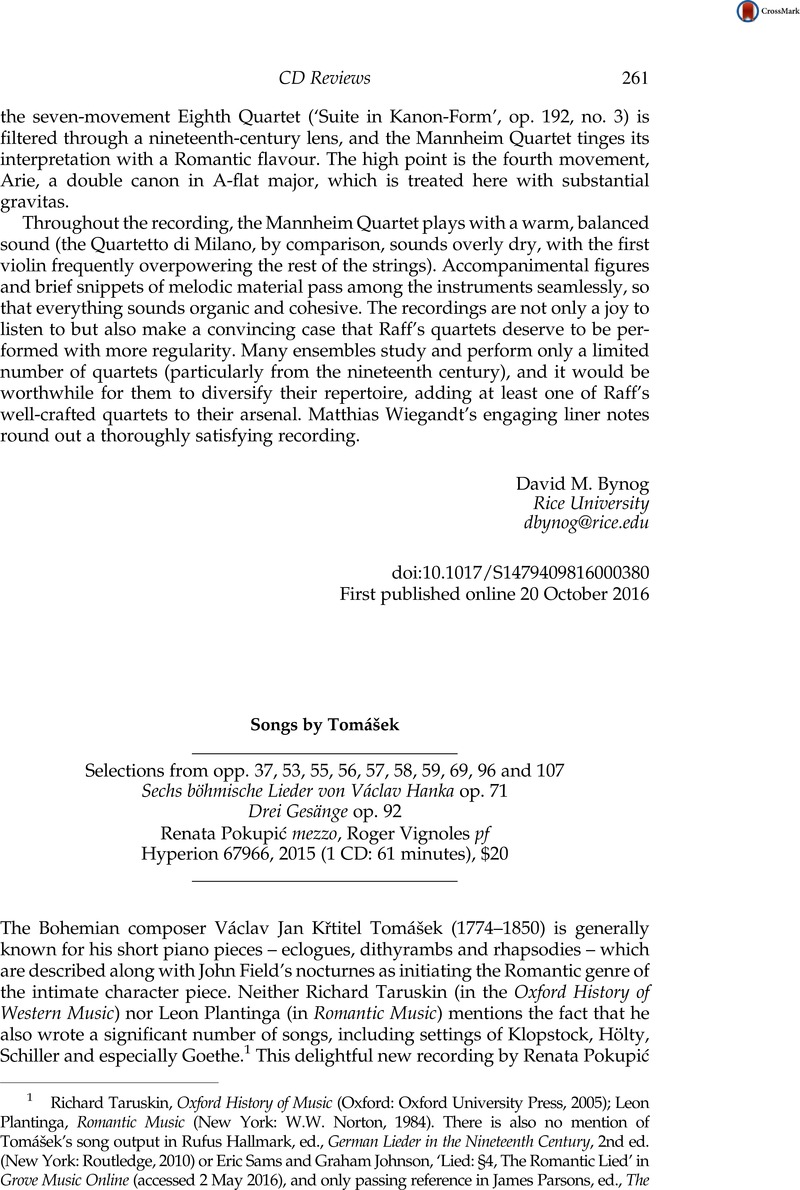No CrossRef data available.
Article contents
Songs by Tomášek - Selections from opp. 37, 53, 55, 56, 57, 58, 59, 69, 96 and 107 - Sechs böhmische Lieder von Václav Hanka op. 71 - Drei Gesänge op. 92 - Renata Pokupić mezzo, Roger Vignoles pf - Hyperion 67966, 2015 (1 CD: 61 minutes), $20
Review products
Published online by Cambridge University Press: 29 November 2016
Abstract

- Type
- CD Reviews
- Information
- Copyright
- © Cambridge University Press 2016
References
1 Taruskin, Richard, Oxford History of Music (Oxford: Oxford University Press, 2005)Google Scholar; Plantinga, Leon, Romantic Music (New York: W.W. Norton, 1984)Google Scholar. There is also no mention of Tomášek’s song output in Hallmark, Rufus, ed., German Lieder in the Nineteenth Century, 2nd ed. (New York: Routledge, 2010)Google Scholar or Eric Sams and Graham Johnson, ‘Lied: §4, The Romantic Lied’ in Grove Music Online (accessed 2 May 2016), and only passing reference in Parsons, James, ed., The Cambridge Companion to the Lied (Cambridge: Cambridge University Press, 2004): 56 Google Scholar. The most significant and widely available secondary sources on Tomášek’s songs are Kenneth DeLong, ‘Tomášek, Václav Jan Křtitel’ in Grove Music Online and ‘Jan Václav Tomášek’s Goethe Lieder’, Kosmas: Journal of Czechoslovak and Central European Studies 7/1–2 (1988): 71–90. See also two critical essays: Herbert Zeman, ‘“Sie Haben das Gedicht Verstanden”: Goethes Aufnahme von Wenzel Johann Tomascheks Gedichte von Goethe für den Gesang mit Begleitung des Piano-Forte’ and Hartmut Krones, ‘Tomascheks Goethe-Lieder der Jahre 1815ff’, both in Tomaschek, Wenzel Johann, Gedichte von Goethe für den Gesang mit Begleitung des Piano-Forte, ed. Ildikó Raimondi (Münster: Lit Verlag, 2003): 5–13 and 15–25Google Scholar.
2 DeLong observes that the Goethe settings did not receive much critical even at the time, in part because they were printed privately (‘Jan Václav Tomášek’s Goethe Lieder’, 76). Tomášek also seems to have fallen between the cracks of nationalist scholarship, since he was born into a Czech-speaking family in Prague but then became a member of the German-speaking community with ‘only sporadic links with his Czech roots’ (DeLong, ‘Jan Václav Tomášek’s Goethe Lieder’, 74). The majority of Tomášek’s songs are in German.
3 Scores for the songs are not widely available. There is a reproduction of the opp. 53–61 Goethe settings with critical commentary in Tomaschek, Gedichte von Goethe. A facsimile of the op. 54 set (mislabelled as op. 34) is available on IMSLP, http://imslp.org/wiki/Category:Tom%C3%A1%C5%A1ek,_V%C3%A1clav_Jan (accessed 3 May 2016), and a facsimile of the Six Bohemian Songs is available online through the Notendrucke der Bayerischen Staatsbibliothek collection of the Münchner DigitalisierungsZentrum, http://daten.digitale-sammlungen.de/bsb00013284/image_1 (accessed 3 May 2016).
4 Eduard Hanslick reported on Tomášek’s affinity for Mozart; Hanslick studied with Tomášek for four years in the 1820s. See Zeman, ‘“Sie Haben das Gedicht Verstanden”’, 6 and Delong, ‘Jan Václav Tomášek’s Goethe Lieder’, 74.
5 See Harry Seelig, ‘The Literary Context: Goethe as Source and Catalyst’, in German Lieder in the Nineteenth Century, ed. Hallmark, Rufus, 2nd ed. (New York: Routledge, 2010): 1–34 Google Scholar. Thirty-four of Tomášek’s Goethe settings are for solo voice and piano; see DeLong, ‘Jan Václav Tomášek’s Goethe Lieder’, 76.
6 Zeman, , ‘“Sie Haben das Gedicht Verstanden”’, 6–7 Google Scholar. See also DeLong, , ‘Jan Václav Tomášek’s Goethe Lieder’, 84 Google Scholar.
7 Rufus Hallmark comments on an analogy between poetic and musical structure in Schubert’s setting of ‘Heidenröslein’, but the rising sequence and cadence of Tomášek’s phrase seems to match the trajectory of lines 3–5 in the first stanza even more closely. See Hallmark, , ‘On Schubert Reading Poetry: A Primer in the Rhythm of Poetry and Music’, in Of Poetry and Song: Approaches to the Nineteenth-Century Lied, ed. Jürgen Thym (Rochester, NY: University of Rochester Press, 2010): 22–23 Google Scholar.
8 A detail in Richard Wigmore’s translation for ‘Wandrers Nachtlied’ seems to be based Schubert’s version of the text, not Goethe’s text as set by Tomášek. Wigmore translates the line ‘Doppelt mit Erquickung füllest’ as ‘doubly with delight’ – which matches Schubert’s version, ‘Doppelt mit Entzückung füllest’.
9 I develop and apply this method of annotation in Malin, Yonatan, Songs in Motion: Rhythm and Meter in the German Lied (New York: Oxford University Press, 2010): 15–29 CrossRefGoogle Scholar. Brackets in the annotation indicate poetic lines.
10 Krones discusses song forms in the Goethe settings; he identifies 11 in strophic forms, five in varied strophic forms, nine in ternary forms, and 15 through-composed songs. See Krones, ‘Tomascheks Goethe-Lieder der Jahre 1815ff’, 16–17 Google Scholar.
11 Krones traces notable appearances of the Neapolitan and other chromatic harmonies in Tomášek’s Goethe settings. Neapolitan harmonies can be found in the closing phrases of ‘Schäfers Klagelied’ op. 56, no. 2, and ‘Erlkönig’ op. 59, no. 1. See Krones, , ‘Tomascheks Goethe-Lieder der Jahre 1815ff’, 23–25 Google Scholar.





